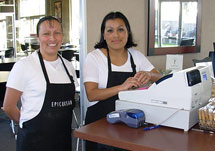Have Gun, Will Travel (at Light Speed)
David Dowell (left) and Cecile Limborg took part in the multidisciplinary collaboration to design and build the gun that will initiate the electron pulse for the LCLS. (Click on image for larger version.)
by Brad Plummer
The front third of the linac is undergoing an extreme makeover, metamorphosing into a first-of-its-kind hard x-ray free-electron laser, the Linac Coherent Light Source (LCLS). But even with the engineering magic embodied by hi-tech vacuum chambers, magnets, undulators and diagnostic equipment from top labs across the country, the LCLS will stand idle without one final, crucial piece of the puzzle: electrons.
That's where the radio frequency (RF) electron gun comes in, an engineering marvel that does one job exceedingly well: under the shine of a special laser, the gun creates a precisely shaped pulse of electrons which it
kicks into the linac. The electrons then zip through to the business end of the LCLS where x-rays are produced.
"Under the direction of the Klystron Department's Erik Jongewaard and with the support of many other SLAC departments, we've created the best RF gun possible," said David Dowell, who leads the team that designed and built the electron gun. "We left no stone unturned. In our eyes it's a thing of beauty."
Read more...
|
 Meet the Faces
of the
Linear Café
by Marcus Woo

Dora and Sylvia Ramirez
(Click on image for larger version.) Anyone who's been to the Linear Café for lunch or coffee will surely recognize Dora and Sylvia Ramirez. The two sisters have greeted customers with warm smiles every day at the cash register for nearly two years.
"I like my job very much," said Dora, who's the older sister by five years. "I like everything about it." In addition to working the cash register and making sure the coffee station and tables are clean, she's also the one who makes the to-go sandwiches every morning. But what both Dora and Sylvia seem to enjoy the most is interacting with coworkers and their customers, some of whom have become good friends.
The kindness of strangers made a lasting impression on Sylvia when she first came to work at SLAC. At the time, she was pregnant with her son, and even though she didn't know anyone yet, people showered her with maternity gifts and clothes. Sylvia also has a daughter and Dora has a son; both are 12.
The two sisters, who came to the U.S. from Oaxaca, Mexico almost 17 years ago, are clearly very close. They've worked together for nearly 12 years, and even live together along with their mother and their children. They worked at Stanford University cafeterias for seven years before heading up the road to SLAC. They prefer the fewer crowds and more intimate environment of SLAC, they said.
When asked if sibling rivalry is ever an issue, Dora emphatically shakes her head. Sylvia says problems never come up. "I help her, and she helps me. We're very good friends and sisters."
|
ILC NewsLine:
EuroTeV and MAC Meeting at Daresbury
by Brian Foster,
GDE European Regional Director
 The holiday period has been a busy time for the
International Linear Collider (ILC) Global Design Effort (GDE). Shortly before Christmas many of us gathered at SLAC to have a first look at the
Reference Design Report (RDR) and its costings with some distinguished external reviewers. The holiday period has been a busy time for the
International Linear Collider (ILC) Global Design Effort (GDE). Shortly before Christmas many of us gathered at SLAC to have a first look at the
Reference Design Report (RDR) and its costings with some distinguished external reviewers.
Hardly had the New Year arrived when we met again, congregating from around the world to present this information, informed by many useful comments at SLAC, to the Machine Advisory Committee, chaired by Ferdinand Willeke of the Deutsches Elektronen-Synchrotron (DESY). The meeting took place at the impressive new building at Daresbury Laboratory near Warrington, UK, that houses two separate but intimately related
organizations. One is ASTeC, the accelerator R&D arm of the Central Laboratory for the Research Councils in the UK; the other is the Cockroft Institute, one of two accelerator institutes founded somewhat over two years ago by PPARC, the UK funding authority for particle physics and astronomy. The other PPARC foundation is the John Adams Institute at Oxford and Royal Holloway University of London. The facilities at Daresbury are excellent, and were greatly conducive to a very productive week for the ILC project.
The MAC was far from being the only meeting at Daresbury last week. On Monday and Tuesday the EuroTeV Collaboration gathered for its annual meeting, to review progress on this project sponsored by the European Union. The EuroTeV Collaboration is funded under the 6th Framework Program for European R&D and has as its purpose the development of a variety of techniques essential for the ILC across the whole gamut of accelerator physics.
Read more...
|
Lab Announcements
Community Bulletin Board
|





 <%
Response.AddHeader "Last-modified", getArticleDate()
'Response.AddHeader "Last-modified","Mon, 01 Sep 1997 01:03:33 GMT"
'Monday, December 06, 2010
%>
<%
Response.AddHeader "Last-modified", getArticleDate()
'Response.AddHeader "Last-modified","Mon, 01 Sep 1997 01:03:33 GMT"
'Monday, December 06, 2010
%>